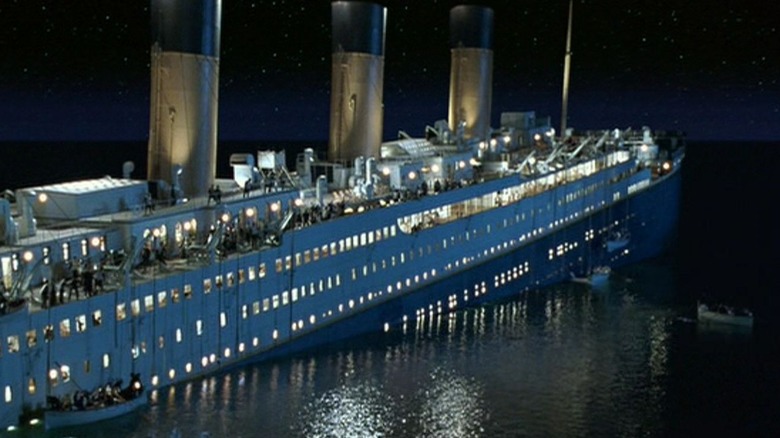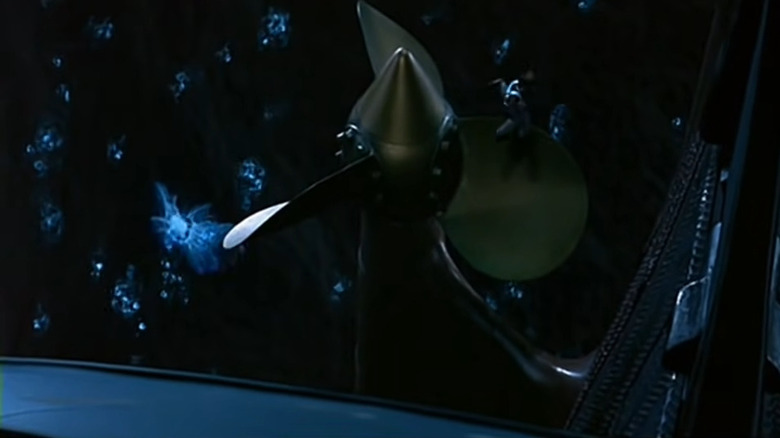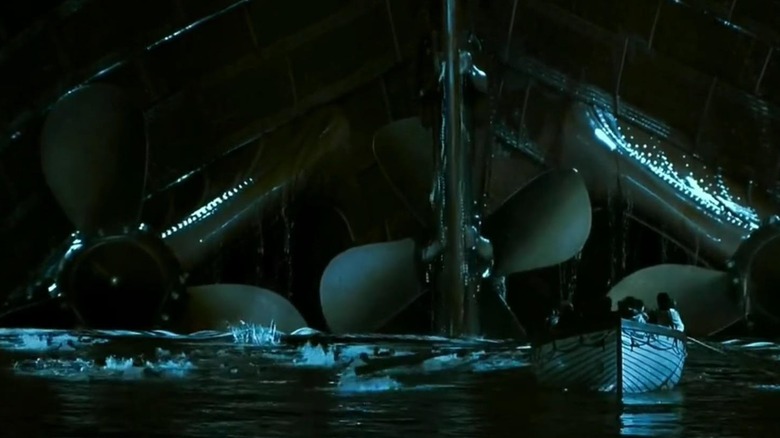Titanic's Visual Effects Team Secretly Modeled 'Propeller Guy' On One Of Their Bosses
James Cameron explores in detail how the Titanic sunk in his 1997 ultra-blockbuster "Titanic." It sideswiped an iceberg on its starboard side, tearing a hole in the hull. The ship began taking on water and the bow began to sink, lifting the stern into the air. The entire ship cracked in half like a Twix bar. The front half continued to sink, shooting to the ocean floor. The stern stuck was next to go, and — because it was already half-submerged — stuck straight up out of the water, almost vertically, like a tower. It, too, then slid beneath the waves. It took about two hours and 40 minutes for the ship to sink entirely.
Cameron compresses that sinking time into about an hour of film, careful to dramatize every detail of the ship's final moments. In the final phase of the ship's sinking — when the stern was standing like a tower — Cameron depicts desperate passengers climbing up the deck, trying to stay perched on the Titanic's rear end. There is a lot of scrambling and panic as people grab onto whatever handholds they can find. Notably, a man falls and plummets toward the ship's now-exposed propellors. As he falls, he thwacks his legs on a propellor, sending his body pinwheeling. He lands in the icy water below, presumably dead.
The character is a random, unnamed victim and is not based on any real-life people. Fans of Cameron's film refer to him merely as Propellor Guy. His death is horrifying, but the near-slapstick timing of his ostentatious demise is admittedly hilarious.
In 2017, a 'blog called VFXblog wrote an entire history of the Propellor Guy scene. The author found that the "Titanic" VFX technicians secretly created the character to resemble Jon Landau, one of the film's producers.
Jon Landau
VFXblog explained that many of the falling bodies in the final sinking sequence were digital models. When "Titanic" came out in 1997, cinema was transitioning from practical effects to ever-evolving digital imagery, leaving it right in a sweet spot. "Titanic" was allowed to take advantage of the best VFX movies had to offer, skillfully blending outsize sets, realistic models, photographic tricks, and CGI to make some of the most impressive visuals ever seen in the history of the medium.
In 1997, however, CGI wasn't yet sophisticated enough to render realistic skin tones or even human faces, so a lot of the crewmates seen panicking during the final moments of the Titanic's life are little more than blob-faced figures, only rendered enough to make them look human for a few moments. Each figure was scanned from a real person, but the actual animation was deliberately a little blurry. This was a fine shortcut to take as fine details wouldn't be visible by the time "Titanic" hit the big screen.
Visual effect supervisor Rob Legato spoke to VFXblog, revealing that the Propellor Guy was scanned from Landau. Legato felt this was a cheeky way to play a prank on his boss, effectively flinging him (metaphorically) to his doom and hearing a wet clang on the way out. As Legato put it:
"The memorable thing about propeller guy was that I decided to put the producer's face on him. [...] So a scan of Jon was used as the basis of propeller guy. All in good fun, but a bit on the dark side of humor since he falls to a brutal end."
Legato's statement was confirmed by Camille Cellucci, the VFX producer. That was indeed a digital version of Landau's body hitting the propellor. Sorry, Jon.
All in good fun
Cellucci hastened to add thwacking Landau on a propellor was all in good fun, and not meant to be taken as bitter or cruel. The VFX crew had worked on "Titanic" for a long, long time, forming a close work bond. Cellicci explained the prank as follows:
"It was the internal joke of the whole crew for a long time. [...] We were like, 'We're gonna do this crazy thing and put Landau's face on the propeller guy!'"
VFXblog also noted that Propellor Gut was not realized via motion capture, but instead, he was hand-keyframed. "Hand-keyframed" means that a traditional hand animator drew out the notable moments — the keyframes before CGI is used to fill in the space between the keyframes. The animator was Andy Jones, a man who did an exemplary job of calculating the rate of Propellor Guy's fall, and how long it would take for him to plummet from the Titanic's stern to the water. Evidently, though, Cameron thought the fall was too short. Jones had to cleverly re-work Propellor Guy's body size to meet the director's demand. Jones recalled:
"[Cameron] wanted me to double-check the math on it. I assured him that the distance and rate of speed the figure was falling was correct. He then asked me to double the distance he falls from after hitting the propeller to the water. It would have been difficult to push the water plane away without breaking other parts of the shot, so I ended up animating the scale of the figure down to about 60% his size from the propeller to the water, giving the illusion that the figure was falling farther than he really was. The trick worked and Jim approved the shot."
R.I.P. digital Jon Landau, hit by a propellor and shrunk 40%.


